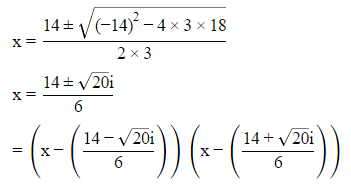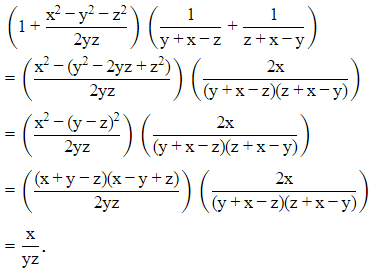Class 8 Maths Chapter 12 HOTS Questions - Factorisation
Q1: Factorize:
6x2 +11x−10
Ans: 6x2+11x−10
=6x2+15x−4x−10
=3x(2x+5)−2(2x+5)
=(3x−2)(2x+5)
Q2: Factorize:
3x2−14x+18
Ans: 3x2 −14x+18
Factor with discriminant method,
Q3: Factorize the following:(16−81x2)
Ans: Simplifying 16−81x2
16−81x 2
=(4)2 −(9x)2
=(4+9x)(4−9x)
Q4: Factorise X2 −7X + 10 = 0
Ans: Simplifying X2 −7X+10=0
X2 −5X−2X+10=0
X(X−5)−2(X−5)=0
(X−5)(X−2)=0
Q5: Divide (4x2 −17xy+4y2 )by(x−4y)
Ans: 4x2−17xy+4y2=4x2−16xy−xy+4y2
⇒4x(x−4y)−y(x−4y)
⇒(x−4y)(4x−y)
=(4x−y)
Q6: Factorise:15x+5
Ans: Simplifying 15x+5.
15x+5=5(3x+1)
Q7: Factorize: 2x2 −7x−15
Ans: Simplifying the equation,
2x2 −7x−15
=2x2 −10x+3x−15
=2x(x−5)+3(x−5)
=(2x+3)(x−5)
Q8: Simplify:
Ans: Now,
Q9: Factorize y2 −(a+b)y+ab
Ans: Step 1: Open the bracket and simplify.
y2 −(a+b)y+ab=y2 −ay−by+ab
=y(y−a)−b(y−a)
=(y−a)(y−b)
Hence, (y-a) (y-b) are the two factors.
Q10: x3−2x2−x+2
Ans: x3−2x2−x+2
=x2(x−2)−1(x−2)
=(x2−1)(x−2)
=(x+1)(x−1)(x−2)
Q11: Factorize
Ans:
Hence, the answer is 
Q12: Find the factors of y2 −7y+12.
Ans: y2 −7y+12
y2 −3y−4y+12
y(y−3)−y(y−3)
(y−3)(y−4)
∴ y=3,4
Q13: Factorise: 2p(x+y)−3q(x+y)
Ans: Since in the expression 2p(x+y)−3q(x+y), (x+y) is the common term, therefore, can be factorised as follows:
2p(x+y)−3q(x+y)=(x+y)(2p−3q)
Q14: Factorise: 3x2 +6x+6
Ans: Since in the equation 3x2 +6x+6, 3 is the common term, therefore, can be factorised as follows:
3x2+6x+6=3(x2+2x+2)
Q15: Factorise: 4abx2 +8abx+12aby
Ans: Since in the equation 4abx2 +8abx+12aby, 4ab is the common term, therefore, can be factorised as follows:
4abx2 + 8abx+12aby=4ab(x2 + 2x + 3y)
Q16: Factorise: 18x2y=24xyz
Ans: Since in the expression 18x2y−24xyz, 6xy is the common term, therefore, can be factorised as follows:
18x2y−24xyz=6xy(3x−4z)
Q17: Factorise: 5x2 - 20xy
Ans: Since in the expression 5x2 −20xy, 5x is the common term, therefore, can be factorized as follows:
5x2−20xy=5x(x−4y)
Q18: Factorize: 4(a+b)2 −6(a+b)
Ans: Since in the expression 4(a+b)2 −6(a+b), 2(a+b) is the common in both the terms,
therefore, the given expression can be factorised as follows:
4(a+b) 2−6(a+b)
=2(a+b)[2(a+b)−3]
=2(a+b)(2a+2b−3)
Q19: Factorise m2 +m+1=0.
Ans: m 2 +m+1=0
factorise this quadratic equation by
Discriminant method.
D=1−4×1=−3

⇒m=−1± √3i
∴m= √3i−1or(− √3i−1)
Q20: Factories the given algebraic expression by taking out the common terms. Also, write the common term
5pq+20p3 q3 −15p2 q
Ans: We first factorize each term of the given expression 5pq+20p3q3 −15p2q as shown below:
5pq=5×p×q
20p3 q3 =2 × 2 × 5 × p × p × p × q × q × q
15p2q = 3 × 5 × p × p × q
The common factors are 5,p and q, therefore, the HCF is 5×p×q=5pq.
Now, by taking out the common term(HCF), we have:
5pq+20p 3 q 3 −15p 2 q=5pq(1+4p 2 q 2 −3p)
Hence, the common term is 5pq.
|
81 videos|423 docs|31 tests
|





















